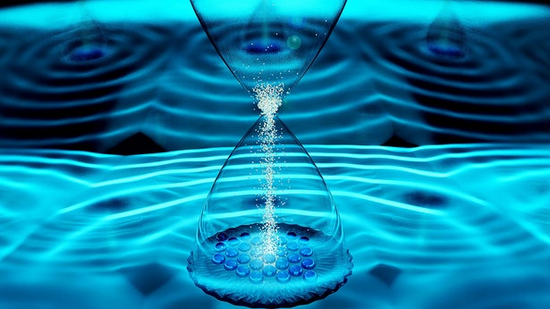A new phase of matter, called a time crystal, has been created and observed for the first time. In a regular crystal, the atoms are arranged in a pattern that repeats itself across physical space, but in a time crystal, that pattern repeats through time instead. The possibility of their existence was first proposed in 2012, but they were deemed “forbidden” according to the laws of thermal equilibrium. The creation of time crystals marks one of the first steps into a new class of non-equilibrium phases.
MIT’s Frank Wilczek first put forward the idea of a time crystal in 2012, inspired by the consideration that the repeating atomic structure of a crystal could be applied to time as well as space. Over the next few years, papers were published on both sides of the argument: some giving evidence for why they were impossible, while others suggested potential methods for making them. In 2016, a team from the University of California, Berkeley outlined how to create time crystals in a lab environment, and it’s this technique that’s finally borne fruit.
To illustrate the weirdness of time crystals, Norman Yao of the UC Berkeley team and this current study, used the example of tapping on a bowl of Jell-O. You’d expect it to respond instantly with a jiggle that slowly settles back down until it becomes still again, and the jiggling would only restart if you tap it again. Time crystals, on the other hand, react in ways that seem impossible to the casual observer: their atoms might “jiggle” after a delay, and then repeat the movement at regular intervals independent of the driving force.
“Wouldn’t it be super weird if you jiggled the Jell-O and found that somehow it responded at a different period?” Yao explains, in a statement back in January. “But that is the essence of the time crystal. You have some periodic driver that has a period ‘T’, but the system somehow synchronizes so that you observe the system oscillating with a period that is larger than ‘T’.”
In most matter, hotter atoms will pass heat to adjacent cooler ones, until they all reach the same temperature. When that happens, the atoms settle into a state known as thermal equilibrium. But time crystals never reach that state, repeating the pattern of movement over time in an apparent display of perpetual motion. That makes them one of the first examples (if not the first) of non-equilibrium phases, a new type of matter.
“This opens the door to a whole new world of non-equilibrium phases,” says Andrew Potter, one of the researchers on the study. “We’ve taken these theoretical ideas that we’ve been poking around for the last couple of years and actually built it in the laboratory. Hopefully, this is just the first example of these, with many more to come.”
To create the time crystal, the researchers used ions of the element ytterbium. First, they levitated the ions electrically, then hit them with laser pulses that flipped them upside down. By blasting them regularly with lasers, the ions fell into a repeating pattern of flips.
That sounds pretty basic, but here’s the kicker: the ions were only flipping once for every two laser pulses, meaning the pattern was operating on a time scale larger than the driving force. Strange as that sounds, it was the behavior the team expected, and helped to confirm that they had created a time crystal.
While it’s hard to visualize a day-to-day application for this kind of discovery at this early stage, the researchers say that future non-equilibrium phases could be used in quantum computing, for storing or transmitting information.

